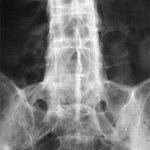In the study, 60 of the patients with SpA were positive for HLA-B27 and 148 of the patients with AS were positive for HLA-B27. The investigators performed multivariable logistic regression using age, sex, HLA-B27 status, duration of disease and diabetes mellitus status as independent variables. They found patients who were HLA-B27 positive had more severe radiographic damage as measured by mSASSS and PASRI than those who were HLA-B27 negative. Likewise, patients who were negative for HLA-B27 were more likely to have bilateral normal sacroiliac joints (grade 0 or 1), and less likely to have bilateral grade 4 sacroiliac joints than those who were HLA-B27 positive. Although not all patients in the study had syndesmophytes on the anteroposterior view of the lumbar spine, syndesmophytes were more frequently seen in HLA-B27 positive individuals than in HLA-B27 negative individuals, and the only predictor of syndesmophyte symmetry was HLA-B27 positivity. However, HLA-B27 positivity was not associated with sacroiliac symmetry.
The current study suggests there is less difference in radiographic phenotype between AS and axial PsA than has been previously documented. It emphasizes the importance of HLA-B27 status in the radiographic severity and phenotypic expression of disease. The authors conclude that their study has implications for the diagnosis and classification of spondylitis in people with psoriasis. In particular, the authors feel that existing classification criteria may not be applicable to axial PsA.
Axial Involvement in PsA
Lead investigator Philip S. Helliwell, MD, professor of Clinical Rheumatology at the Leeds Institute of Rheumatic and Musculoskeletal Medicine, U.K., explains that although there is axial involvement in PsA, the presentation can differ from axial involvement in AS. He feels that most rheumatologists are familiar with the classical presentation of axial involvement seen in patients with AS and may be unaware of the non-classical presentation that can occur in patients with PsA. His study tested the hypothesis that the radiographic phenotype of patients with axial SpA depends on the presence of HLA-B27 as opposed to the diagnosis of PsA or AS and his results suggest the genotype drives the phenotype.2
Dr. Helliwell points out that this evidence builds on a body of data going back to 1971 when McEwen et al. published a comparative study indicating that spondylitis associated with psoriasis has a close resemblance to spondylitis associated with reactive arthritis and has features that distinguish it from AS. In their seminal study, the researchers noted the asymmetry and distinctive syndesmophytes in psoriasis and proposed several hypotheses to explain the differences between classical axial SpA and non-classical axial SpA (psoriatic and reactive).3


